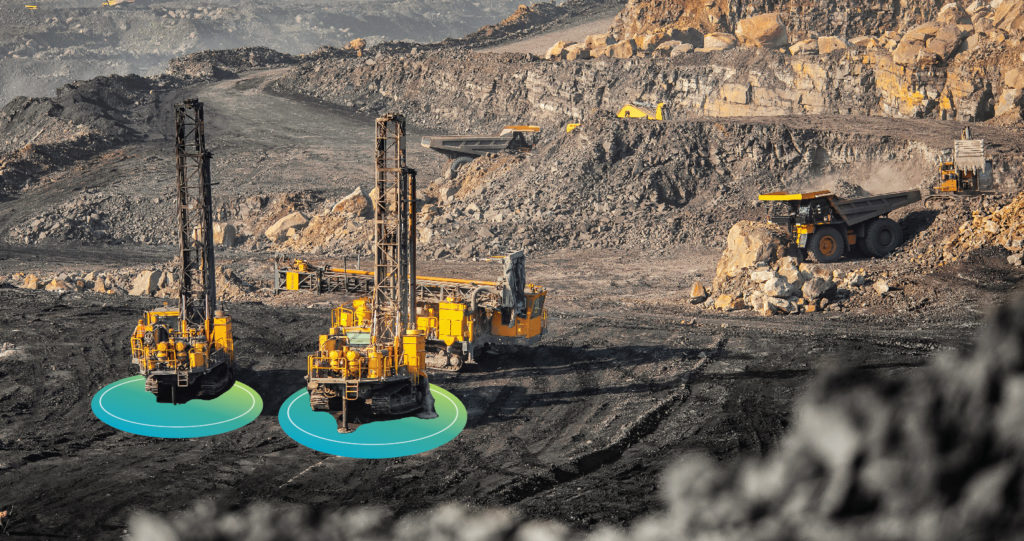At the SME MINEXCHANGE conference and expo this week in Phoenix, Arizona, IM caught up with Curtis Stacy, Senior Product Manager – Autonomous Drills at Hexagon Mining. He gave a much anticipated presentation updating attendees on Hexagon Drill Assist.
While many drill automation solutions have been developed over the last 20 years, including a variety of aftermarket offerings along with each of the major OEM’s offering their own version of the technology, Stacy said Hexagon has taken blasthole drill automation to a new level by leveraging artificial intelligence (AI) in the drill algorithm & eliminating the need for manually entering drilling parameters, thereby reducing human interaction to nearly zero.
He added that new operator training is significantly reduced, empowering trainees to perform at expert production levels when they first start in operations. And crucially, all of this is accomplished without physically modifying anything on the OEM control platform, thereby protecting mining customers’ existing supply and support networks.
IM spoke to Curtis Stacy at the 2024 SME MINEXCHANGE in Phoenix

Standard drill automation solutions rely on Boolean logic for control response. In other words, a parameter is set by an operator or supervisor for each condition that must be monitored by the drill automation system. As an example, algorithms used in existing systems to protect the drill bit from becoming plugged or stuck down the hole require human input to tell the automation system when each condition occurs.
Such technology requires one of two approaches. First performance biased – an aggressive parameter (such as plugged air pressure) is set, allowing the drill to continue to penetrate the ground until a higher setpoint is reached. This approach results in higher instantaneous productivity but puts the machine at risk of getting stuck or plugged, conditions which cost precious operational time to correct.
Second, protection biased – exactly opposite of performance tuning, a conservative parameter is set, resulting in false positives that cost production time spent trying to clear a hole or drill bit that may not actually be plugging up. These solutions can be very complicated and require subject matter expertise to properly tune and optimise in addition to a significant investment in operator training. The lack of expertise typically results in the operator setting the drilling parameters based on a menu, which may or may not be close to the actual conditions. The Hexagon solution derives these parameters autonomously, ensuring optimised drilling regardless of ever-changing conditions encountered.
Hexagon set out to improve the limitations of existing drill automation solutions by incorporating AI directly into the control algorithm. By eliminating the requirement for the operator to ‘estimate’ and enter drill site parameters prior to commencing drilling on each hole, new operator training for the drilling process was reduced to just 15 minutes for each new operator.
The Hexagon AI solution performs three key functions. Drilling parameters – rotary RPM and force on the bit are now autonomously controlled via the Genetic AI Algorithm that constantly seeks to improve performance of the drill rig within machine and drill bit limitations. The Genetic AI Algorithm automatically determines when ground conditions are stable enough to allow parameter testing; once stable ground is detected, the algorithm automatically changes one of the drilling parameters and measures the overall performance.
If the performance is improved, the new parameter becomes the baseline and another test is initiated. If performance is adversely affected, the new parameter is made extinct and another test is initiated. Following the principles of Darwin’s theory of evolution, parameter changes that result in loss of performance are superseded by changes that significantly improve performance; this results in always using the best possible drilling parameters for any given ground condition. Baseline parameters are controlled based on rate of penetration, and all parameters must operate within machine and drill bit manufacturer limitations. Stacy says that this combination ensures highest possible production whilst providing the optimal machine and consumable life.
At the heart of the Hexagon drill automation system is the decision engine. The decision engine leverages AI to monitor all sensor inputs simultaneously, applying a rules-based decision-making process based on the sensor input levels to generate control responses. This approach allows Hexagon to eliminate nearly all parameters associated with drill automation and provides optimised drill control throughout all ground conditions. The decision engine automatically detects down hole issues and triggers control responses that correct the detected issues before they become significant problems whilst simultaneously filtering the false positives associated with the protection-biased tuning philosophy. The AI in the decision engine and genetic algorithm acts like an expert digital operator, providing exceptional machine protection while optimising productivity.
The Hexagon technology corrects calculation issues by eliminating human influence and by using accurate drilling parameters whilst engaging the ground, as previously outlined. This results in repeatable and accurate ground hardness data that can then be used to improve blasting results downstream.
The solution’s algorithms were created to calculate the hardness of the ground being drilled. Similar in philosophy to the decision-engine technology, the hardness index is based on rules rather than direct measurements. All relevant sensors are monitored simultaneously, and rules are applied to determine a hardness value between 0 (very soft – think air) and 5 (very hard). The AI hardness index seeks to eliminate the operator-induced errors that are present in the existing solutions. Testing of the efficacy of this solution is ongoing.
Initial prototyping of Hexagon’s solution was done on an older Caterpillar drill rig that had no auto drill technology on it. Performance was measured by looking at the productivity rates of the human operators individually and comparing their performance to Hexagon’s Drill Assist application. Data was collected for a three month period using Cat Terrain to record drill performance during that period. While not in use, Drill Assist was deactivated on the host machine to ensure data purity. Stacy says that the results were impressive. Drill productivity increased by 30% overall, per-foot cost of drilling was reduced by 24%, and measured machine stress was reduced by 40%. Per-operator productivity increased 13% over the top-tier operator and 34% over the lowest-tier operator.
Next, Hexagon sought to determine whether the same improvements could be made using a newer drill rig that was already equipped with an OEM automation solution. A new Cat MD6310 was fitted with a Drill Assist kit and tested. Installation of the kit required three days working eight hours on the drill.
Since the Hexagon solution does not require the removal of any OEM hardware or software, when installation activities were not ongoing, the drill rig was returned to operation, reducing the amount of down time required to outfit the drill rig by more than 300 hours over a leading competitor. Data was collected in the same way as the initial testing. The drill was operated in two modes, Hexagon Drill Assist mode and OEM auto drill mode.
Stacy reported that the results were once again impressive. Effective rate of penetration increased 42%. Depending on ground conditions, performance increases exceeding 150% were seen. Generally, the OEM automation struggled in highly fractured or variable ground. The Hexagon solution accurately detected all down hole issues and ground condition changes and automatically corrected them without human intervention. The Hexagon solution had a 100% success rate during this testing, meaning every time an operator initiated the drill cycle, the Hexagon automation system was able to completely drill the hole. No negative impacts to machine health or consumable performance were seen.











